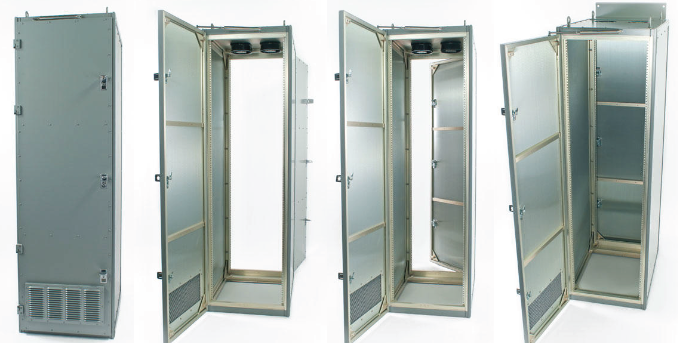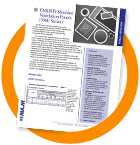Enclosure Shielding Can Be Your First Line Of Defense for Data Centers Against RFI and EMI
Engineers and designers know that RFI and EMI can wreak havoc in data centers, SCIFs, and equipment enclosures of all scopes and sizes.
In this post, we’ll discuss your first line of defense against unwanted access and egress of electromagnetic and radio frequency interference in data center environments and electronic equipment enclosures.
Here’s what you’ll learn:
- What Is Data Center Shielding?
- What Are The Foundational Design Considerations?
- What Are The Basic Types Of Data Center Shielding Products?
- Who Needs Data Center Enclosure Shielding And Why?
- What Are The Next Steps For Your Project?
Ready?
We’ve got a lot to cover, so let’s get started.
What Is Data Center Shielding And What Does It Do?
The purpose of a shielded enclosure is to provide a complete low impedance path for EM and RF signals by addressing all penetration points, structural seams, and apertures.
Proper use of shielding principles and materials will allow any electromagnetic field to propagate on the outside surface of the shielded enclosure without impacting equipment within or on the inside surface if the electromagnetic field is generated inside of the enclosure.
Think basic Faraday Cage design principles. Data centers and equipment enclosures need to be securely protected and sealed against internal and external transmissions, especially EMI and RFI signals.
A Faraday Cage is an enclosure made of electrically conductive materials capable of blocking spurious radio frequency signals, along with magnetic and electrical fields, collectively known as RFI and EMI.
The technical and engineering pundits at TechTarget provide a great high-level definition of the Faraday Cage:
A Faraday cage is a metallic enclosure that prevents the entry or escape of an electromagnetic field (EM field). An ideal Faraday cage consists of an unbroken, perfectly conducting shell. This ideal cannot be achieved in practice, but can be approached by using fine-mesh copper screening. For best performance, the cage should be directly connected to an earth ground.

So how do electrical and military engineers, electronics enclosure and SCIF designers, and system integrators protect against EMI and RFI signal propagation?
The process starts with product selection based on your design requirements.
What Are The Foundational Design Considerations?
You need a diverse array of shielding products to ensure a conductive, low impedance path that will allow any generated electromagnetic field to propagate on the outer, or inner, surface of the shielded enclosure.
Data centers, SCIFs, and equipment enclosures are literally “full of holes.” And those holes need to be secured.
Let’s look at some typical shielding products and their data enclosure design applications.
What Are The Core Types Of Data Center Shielding Products?
First let’s consider the different types of penetrations that create challenges in data center enclosure design.

Courtesy of Iron Mountain Data Centers
Regardless of your specific data center or enclosure type, you’ll need shielded ventilation panels or honeycomb waveguide panels for any enclosure that requires airflow or human access. Power and signal lines that penetrate the shielded enclosure must also be protected to prevent unwanted EM transmissions.
Inside shielded enclosures, structural seams along walls and ceilings, as well as all corner seams, must be electromagnetically sealed by welding, conductive gaskets, or conductive caulk.
In addition, shielding for doors, access panels, handles, windows, air ducts, vents and cooling fans need to be included in your data center design.
The net-net of all this?
Data center engineers, designers, and solution integrators need purpose-built shielding products for apertures of all types, shapes, and sizes.
These include:
- Honeycomb Waveguide Panels
- EMI Door/Window Gaskets – For All Doors and Access Panels
- EMI Washers – For Nuts and Bolts Used On Any Enclosure Surface
- Vent Fans and Panels
- Honeycomb Ventilation Panels – HVAC Units, Ducts, Fans
- EMI Connector Gaskets – For Electrical/Power and Telecom Cables, Panels, etc.
- EMI Gaskets For All Access, Egress, And Ingress Points
- Shielded Fan Ventilation Panels
- Shielded Air Filter Panels

So Who Needs Data Center Enclosure Shielding And Why?
If you’re an EMI/RFI engineer, military engineer, SCIF, data center/electronics enclosure designer, or systems integrator, you need a trusted source for shielding products and resources.
We’ll help you analyze your design elements and identify your shielding requirements.
Always keep in mind that the fundamental principle of a shielded enclosure is to provide a complete low impedance path by addressing all potential penetration points and apertures.
What kind of enclosure are you designing or building? It might be a SCIF, a data center rack, a shielded electronic component enclosure, etc.
Whatever your project entails, the team at MAJR Products is here to help.
Your Source For Data Center Shielding Products
We’re here to ensure you have the right shielding solutions for your military or civilian use applications, standards, and project requirements.
The team at MAJR Products is here to help you confidently spec and source shielded enclosure products in the sizes, material combinations, and configurations you need.
Why should you establish a trusted relationship with us?
Here are just a few reasons why:
- 50 Years of Engineering Experience At Your Disposal
- Tempest Compliant Products
- Custom Design Solutions
- Veteran Owned Business
- Products Manufactured in the USA
- ISO Certified 9001:2015
- Engineering / Design Assistance Available
- Military Grade Products
- Registered Small Business
At MAJR Products, we understand the need for competitive pricing and short product lead times. We also offer product and application design guides as well as assistance from our shielding experts.
Can we help streamline your next project together?
Let’s find out.You can get in touch with us online or simply visit our website and click the “Request a Quote” button on the upper right-hand side of any page. For more information, you can also call us anytime at (877) 625-6033.

